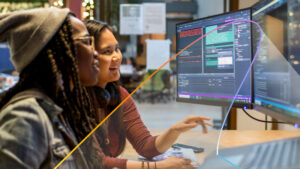
Bringing technology for good stories to life
Haiyan Zhang, Innovation Director at Microsoft Research Cambridge, is a designer, technologist and maker of things.
She is also an inventor appearing in the BBC series, Big Life Fix, of which the second season starts on July 5th. Haiyan has a Masters degree with Distinction in Interaction Design from the renowned Interaction Design Institute in Ivrea, and has a Bachelor of Computer Science (First-Class Honours) from Monash University, Australia.
I am always looking for ways to fix real life challenges.
As the Director of Innovation at Microsoft Research Cambridge, my aim is to push the boundaries of technology to transform people’s lives for the better.
I have spent about 20 years in the technology sector, focussing on software engineering, user experience, research and development, service design, cloud platforms, design thinking, and blue-sky envisioning.
My training in user-centred design means I am always observing how people interact with technology and talking to people to gain insight into their lives which I can then draw upon to find ways that technology can support them.
I didn’t set out to work specifically in technology for good, but it has been a very fulfilling experience. I’ve been lucky enough to work on Project Emma, Project Zanzibar, Project Fizzyo, and Project Torino – projects which all find fixes to real problems in society.
One of the great things about working for Microsoft Research is it opens you up to new experiences. My team and I have been lucky enough to work on a BBC program, Big Life Fix, where we helped people solve issues that make their everyday lives easier.
In the first season, we created the Emma Watch, a wearable device that uses rhythmic vibrations to help Emma Lawton, a graphic designer who suffers from Parkinsons, to draw again by counteracting her tremors.
Emma continues to use the watch today and has become an advocate for Parkinsons sufferers.
Now seen over 63 million times, it’s really highlighted the fact that there are new territories to be explored in terms of how connected technologies can support people with disabilities. There’s a lot of fantastic work going on with finding a cure or different ways to treat the symptoms of Parkinson’s and we took a very design-centred approach to a very particular problem.
We’ve worked with University College London for the past year, recruiting 16 patients who suffer from Parkinson’s to test the watch. The results were all positive, and now we’re talking with different institutions globally to widen the study and research of the watch.
Another project that came from Big Life Fix was Fizzyo. Project Fizzyo is designed to help cystic fibrosis suffers by gamifying physiotherapy. Breathing exercises have been used for decades to help those who suffer from cystic fibrosis clear mucus from their lungs and help them breathe.
The Coxhead family has two boys who have cystic fibrosis and Vicky, the mum, struggled to get them to complete their breathing exercises as they grew older – they were much more interested in playing football!
Vicky was the one who suggested connecting the exercises to video games. Just by listening to her and her family’s stories we were inspired to create a prototype that gamified their breathing exercises.
Even though this was inspired by one family, we realised that thousands of families across the UK face the same issue – more than 10,800 people in the UK have cystic fibrosis and some must complete the 30-minute breathing exercises up to three times a day.
Great Ormond Street Hospital and University College London (UCL) physiotherapy department have taken on the project and are rolling it out across the UK for a long-term study.
Not only is this technology helping solve problems and make life easier for families like Vicky’s, but it’s also helping research and creating digital disruption within industry – the UCL physiotherapy department had never thought about doing any studies with digital technology and now they have their own data scientist.
By being connected to this device, data is being collected on Microsoft Azure, and the medical practitioners can see data from patients and adjust treatment based on their individual needs.
Our technology is the first time they’ve accurately tracked how kids are doing the exercise and how often they are doing it.
The hope is that with this study we can prove that doing these exercises will help improve the long-term health of these kids.
I would never have had the time to work on these projects without the support of Microsoft Research. I am very lucky that they encourage me to pursue these passion projects. Satya has been a real inspiration, talking about the growth mindset and how we should think about Microsoft as a platform for achieving our ambitions and passions.
I love that outlook and perspective. It’s not about a work-life balance, but about a work-life-passion balance and the fact that they support this is great.
I hope this encourages not only people at Microsoft, but people within the technology sector and other corporations to become platforms that support society and empower more people.
In innovation, everybody has a role to play, their own skills, perspectives, and experiences contribute to a creative process, using technology to empower others. So, go out, look for challenges around you and try to solve these problems.
Take a listen to our podcast to find out more about some of these projects and the techniques I use to bring technology for good stories to life.
Listen to the podcast: Bringing technology for good stories to life

Discover more
Empower young people to solve problems around them using technology




